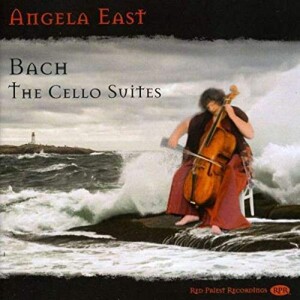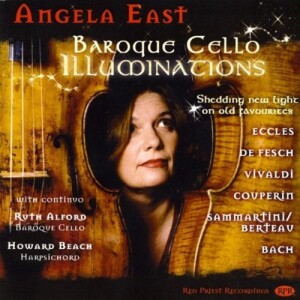Angela East is the cellist for Red Priest, the baroque chamber ensemble noted for its innovative approach and flamboyant public style. In the two recordings presented here, East has gone solo, pretty much, and brought this approach to the smaller-scale works of Johann Sebastian Bach and other baroque masters.
 Bach wrote the Cello Suites while employed as Kapellmeister to Prince Leopold in Cöthen, a somewhat idyllic venue for a musician of the time: the Prince was an enthusiast who played several instruments himself and employed 18 musicians, providing Bach ample opportunity to compose. Unfortunately, the Prince’s new wife, whom he married in 1721, was not so sympathetic, and the Prince’s interest waned. Bach soon moved on to Leipzig. All of which leads to the scholarly opinion that the Suites were written before 1720.
Bach wrote the Cello Suites while employed as Kapellmeister to Prince Leopold in Cöthen, a somewhat idyllic venue for a musician of the time: the Prince was an enthusiast who played several instruments himself and employed 18 musicians, providing Bach ample opportunity to compose. Unfortunately, the Prince’s new wife, whom he married in 1721, was not so sympathetic, and the Prince’s interest waned. Bach soon moved on to Leipzig. All of which leads to the scholarly opinion that the Suites were written before 1720.
There exists no autograph manuscript for the Suites; the closest we have is a facsimile by Anna Magdalena Bach, of which East notes “her slurs are so wonderfully inconsistent that I have chosen to take her as literally as possible most of the time.” I think that also gives us an idea of East’s own attitude.
Time for another of those awful revelations: Bach is not really my favorite among the baroque composers, and while I can’t dispute the greatness of works such as the Mass in B Minor or the Saint Matthew Passion, most of the cantatas leave me cold, and I can’t forget that the Goldberg Variations were commissioned to put Goldberg to sleep.
That said, it probably comes as no surprise that I don’t find Cello Suites to be the most engaging works I’ve ever encountered, from any period. While demanding enough technically, and substantial enough, I think, for those whose enthusiasm outstrips mine, they are, by and large, low-key works without a lot of bite. East’s playing points up the complexity of the writing (when it happens — it’s not a constant, by any means) and provides ample evidence not only of her ability, which is more than adequate for this material, but also of her intelligence and sympathy to the music.
 The works presented in the collection Baroque Cello Illuminations are generally considered, according to East, “rather simple” pieces normally taught to students in the early part of their studies. However, she contends, given baroque performance practices and period instruments, they take on a dimension far beyond mere “etudes.” The disc contains works by Henry Eccles (junior), Willem de Fesch , Antonio Vivaldi, Giuseppe Sammartini, and the inevitable Johann Sebastian Bach. East is ably supported on this disc by Ruth Alford on baroque cello and Howard Beach (also a member of Red Priest) on harpsichord.
The works presented in the collection Baroque Cello Illuminations are generally considered, according to East, “rather simple” pieces normally taught to students in the early part of their studies. However, she contends, given baroque performance practices and period instruments, they take on a dimension far beyond mere “etudes.” The disc contains works by Henry Eccles (junior), Willem de Fesch , Antonio Vivaldi, Giuseppe Sammartini, and the inevitable Johann Sebastian Bach. East is ably supported on this disc by Ruth Alford on baroque cello and Howard Beach (also a member of Red Priest) on harpsichord.
These are not particularly complicated pieces, and one can see why they are part of the early education of cellists. East does find a fair amount of substance in them, and some of that liveliness that I associate with the baroque, which saves this collection from becoming background music. On the whole, though, this is one, I think, for those who are baroque enthusiasts.
(Red Priest Recordings, 2009)
(Red Priest Recordings, 2009)
